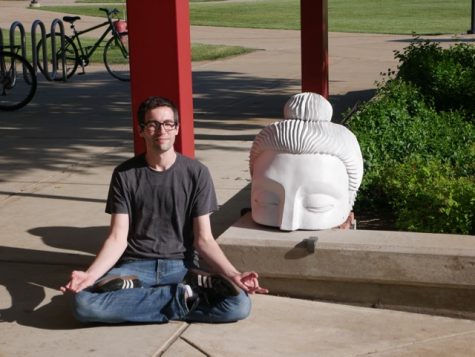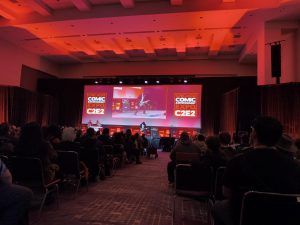‘Tyler Bohm: The future is behind us’
November 9, 2016
We are living in the future. It is undeniable as you look at the technological advances made in the past century. But is it the future that society was expecting? Tyler Bohm explores this question with his exhibit “The Future is Behind Us,” on display in the NEIU Fine Arts Center Gallery until Nov.18.
The artist talk on Oct. 25 gave students and faculty a chance to discuss the various influences behind each of his works.
The exhibit consists of several one-off pieces, as well as two distinct series.
“The Future is Behind Us” is the inspiration for all of the work found in the exhibit. The titular piece is mixed media and plexiglass. Up close it is clear to see that there are layers of painted plexiglass which overlap to create additional dimension and depth.
If you step back about 15 feet it becomes clear that the composite image is that of a 1950s-era, classic American nuclear family, looking into the sky at Earth— implying they are on the Moon.
The rest of the series are mixed media on plexiglass and look very modern and familiar. They almost seem like branded products of a video game company.
“Game of Life” elicits strong nostalgia of 80s arcade games, with a futuristic, almost alien flair.
“Cipher” is a tablet with many of the symbols that appear on the other pieces in this series, all seemingly connected through some sort of grid.
“There’s an implied order within all of these networks and systems but the exact meaning of that order is intentionally elusive,” said Bohm.
This theme of translation is also expressed in “Rosetta Stone,” which is a black plexiglass silhouette of the actual Rosetta Stone, with inscriptions of Asimov’s three laws of robotics, emoji representations of the three laws, and a long binary code sequence.
Finally, “Everything Emulator” depicts one of these futuristic plexiglass pieces as though a virus, eating or infecting (or assimilating) a more traditional, framed painting.
More recently he has created the “Peripheral Visionary” collection.
The pieces are acrylic on wood and plexiglass and are meant to show very little detail when viewed from directly in front. As you move to the periphery of the piece, a portrait appears of a sci-fi writer that Bohm considers influential and ahead of their time.
The three pieces of this collection depict writers Neal Stephenson, Margaret Atwood, and Samuel Delany. He creates the effect by using a grid of strategically painted blocks.
“I feel like these authors are looking at the future from a very different perspective,” Bohm said. “So they seemed like appropriate subjects for portraiture.”
You can see the inspiration for this series in his piece “Mona Lisa Defragged” as well. It is a pixelated image of Mona Lisa composed out of painted blocks, with the “defragged” identical color scheme next to it. “Defragging” is a digital rearrangement of information which allows for easiest storage and retrieval, with the least quality loss.
A lot of his work has been one-offs lately, Bohm said. The inspiration comes from various concepts he wants to explore, involving technology and science fiction.
One of his more interesting pieces, conceptually, is “Drone.” It is a pixelated image of a military Predator drone. The pixels are hexagonal cells in a honeycomb pattern that were filled with beeswax. The various colors were achieved by melting crayons into the wax.
Bohm said he wanted to explore the juxtaposition of the creative nature of a bee drone with the destructive nature of a military drone.
Finally, one piece in the collection stands apart from the others in both media and topic. It is called “Almost Utopia” and consists of hundreds of hand-painted model train figurines, assembled into a group that shapes the commonly known, thumbs-up “Like” symbol from social media sites— with a single figurine near the edge.
Bohm said he was thinking of the herd mentality of social media when he made it. He wanted to explore the concept that if you have more likes, somehow the message you are conveying has more importance or validity.
“That can be sort of a destructive social dynamic sometimes,” Bohm said. “The joke is that this would almost be utopia, if everyone could just form some sort of conformity or some form of consensus. But of course there’s this one person who is off to the edge.”
Tyler Bohm lives in Columbus, Ohio. He has spent several years working in the architectural field, which has clearly influenced both his creative process and his choice of media. The pieces in this exhibit were created between 2014 and 2016. You can stop by the NEIU Fine Arts Center Gallery Mon-Fri from 11 a.m-6 p.m.









